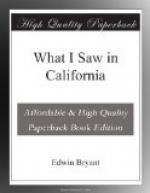Done at Monterey, capital of California,
this first day of March,
A.D. 1847, and in the seventy-first year
of independence of the
United Suites.
S.W. KEARNY
Brig.-Gen., U.S.A., and Governor of California.
The proclamation of General Kearny gave great satisfaction to the native as well as the emigrant population of the country. Several of the alcaldes of the district of my jurisdiction, as well as private individuals (natives of the country), expressed, by letter and orally, their approbation of the sentiments of the proclamation in the warmest terms. They said that they were heartily willing to become Americans upon these terms, and hoped that there would be the least possible delay in admitting them to the rights of American citizenship. There was a general expectation among natives as well as foreigners, that a representative form of territorial government would be immediately established by General Kearny. Why this was not done, is explained by the recent publication of General Scott’s letter to General Kearny, dated November 3rd, 1846, of which Colonel Mason was the bearer, he having left the United States on the 7th November. In this letter General Scott says:—
“As a guide to the civil governor of Upper California, in our hands, see the letter of June 3rd (last), addressed to you by the Secretary of War. You will not, however, formally declare the province to be annexed. Permanent incorporation of the territory must depend on the government of the United States.
“After occupying with our forces all necessary points in Upper California, and establishing a temporary civil government therein, as well as assuring yourself of its internal tranquillity, and the absence of any danger of reconquest on the part of Mexico, you may charge Colonel Mason, United States first dragoons, the bearer of this open letter, or land officer next in rank to your own, with your several duties, and return yourself, with a sufficient escort of troops, to St. Louis, Missouri; but the body of the United States dragoons that accompanied you to California will remain there until further orders.”
The transport ships Thomas H. Perkins, Loo Choo, Susan Drew, and Brutus, with Colonel Stevenson’s regiment, arrived at San Francisco during the months of March and April. These vessels were freighted with a vast quantity of munitions, stores, tools, saw-mills, grist-mills, etc., etc., to be employed in the fortification of the principal harbours on the coast—San Francisco, Monterey, and San Diego. The regiment of Col. Stevenson was separated into different commands, portions of it being stationed at San Francisco, Sonoma, Monterey, Santa Barbara, and Los Angeles; and some companies employed against the horse-thief Indians of the Sierra Nevada and the Tulares.




